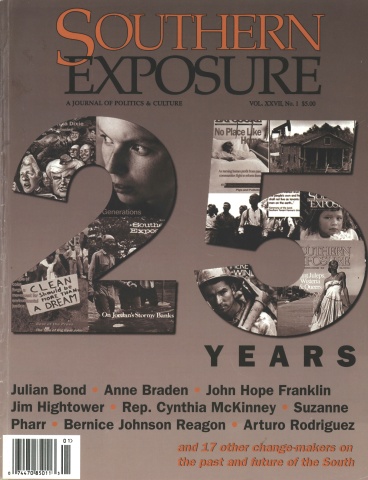It’s Still Southern Exposure

This article originally appeared in Southern Exposure Vol. 27 No. 1, "25th Anniversary Edition." Find more from that issue here.
As anyone who has been involved in the movement for social justice knows, it’s a life cycle with a pattern to it. The young activist starts out serious. After all, it’s serious work and there’s so much to be done, so much injustice, only so many hours in the day. Then burnout hits. One person can only do so much. The activist searches for ways to keep going strong, to keep balance, to inject healthy humor and distractions that keep the well filled.
Southern Exposure has gone through its own activist life cycle. Starting with serious issues on the military machine, labor organizing, and the utility companies, moving through cultural explorations of music, sports and theater, and on to a balance of hard-hitting investigations, political humor, fiction, culture, and tools for change, SE has worked to find its level, its balance. The lighter side of the magazine’s personality doesn’t generally make the headlines. But it’s the fun, the humor, the beauty, and the irony that take the edge off the sadness and anger and keep us coming back to read more and do more.
In the earliest Southern Exposures, political cartoons provided the leavening for the heavy mixture of investigations, analysis, spider charts and book reviews. In the first issue, “The Military & the South,” a massive military watchdog sits on the back of a sweating civilian. On another page, three white men in suits labeled education, military, and industrial march in sync in a fife and drum corp. Not exactly light fare, but enough to provoke a wry smile.
Starting in its second year, some issues of the magazine focused on cultural topics such as literature, folk art, music, dance, theater, history, and sports. “How do we effectively criticize the sports establishment that manages ACC basketball or NFL football,” ask “Through the Hoop” editors Tema Okun and Peter Wood, “when we find ourselves glued to the set at playoff time?” Leave it to SE to expose the deeper political irony that underlies a seemingly benign pastime.
“Facing South,” a regular magazine feature and syndicated column in the late 1970s and early 1980s, covered Southern staples like okra, the Wright Brothers, divorce, and boat building. One featured Jack Holmes, who became Virginia’s first black disk jockey in 1947. Friend to the likes of Duke Ellington and Ray Charles, Holmes was still going strong at age 72 when Institute for Southern Studies writer Frank Roberts interviewed him in 1984.
From the World’s Largest Roach to dwarf tossing, “Dateline: The South” captured irony and humor in short takes from each southern state starting in the late 1980s. In one “Dateline,” officers in Miramar, Florida stripsearched a grandmother for selling Playboy to teen boys in a convenience store, but were nowhere around when her husband was robbed in the store at gunpoint the next night.
In another, the Klan wanted to enter a float titled “I’m dreaming of a white Christmas” in the Gainesville, Georgia, Christmas parade, prompting local protests. The section makes note of South Carolina’s Chitlin’ Strut Festival, the mail-order ordination of Teddy the cat as a United Christian minister in Huntsville, Alabama, and the credit cards available from the Martin Luther King, Jr. Center for Non-Violent Social Change.
In 1991, “Still the South” premiered with a feature on stock car racing. The column continues to blend history and first-hand accounts in its coverage of Southern-grown traditions such as miniature golf, hurricanes, fire ants, collard greens and protest music.
Just as its humor is tinged with political meaning, Southern Exposure’s stories of dark injustice and suffering continue to be tinted with hope, and a belief that change is possible.
Tags
Mary Lee Kerr
Mary Lee Kerr is a freelance writer and editor who lives in Chapel Hill, NC. (2000)
Mary Lee Kerr writes “Still the South” from Carrboro, North Carolina. (1999)